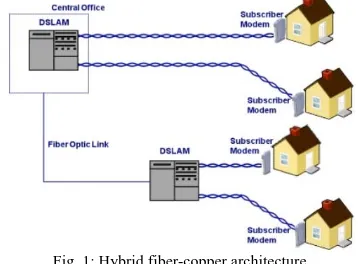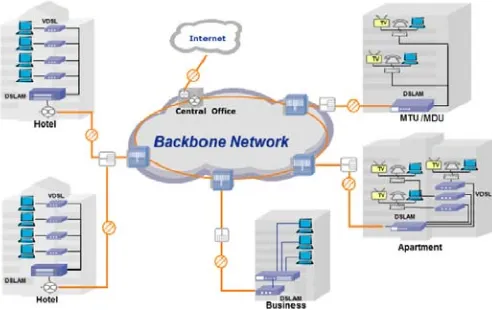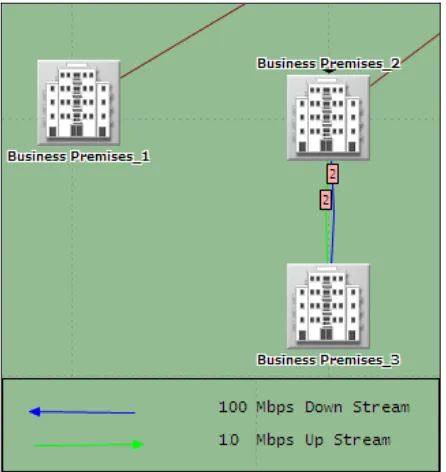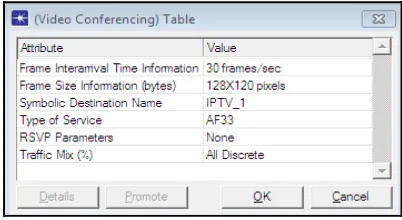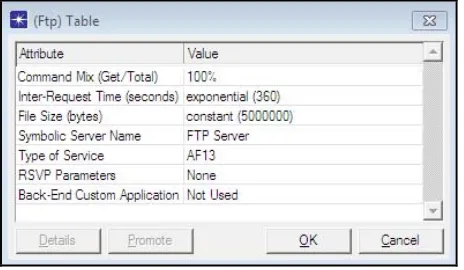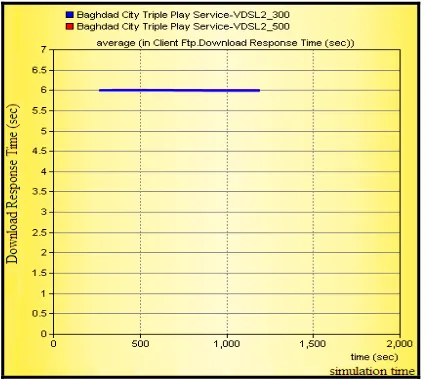Triple Play Services Transmission over VDSL2
Broadband Access Network in MDU
Nasser N. Khamiss, Sara Ali Abed Al-Hussein
Networks Engineering Department,
College of Information Engineering, Al-Nahrain University, Baghdad, Iraq
Abstract
—
This paper lays a prototype of delivering Triple Play services for Baghdad city and studies how to deliver these services for different areas of the region. The paper evaluates the performance of VDSL2 broadband access network as the suggested last mile technology to support the transmission of Triple Play services. A simulation model using OPNET 14.5 modeler provided to illustrate the services transmission over VDSL2 technology and to present it as the feasible access technology for multiple building units which are known as Multi-Dwelling Unit or MDUs. The simulation results will prove the proposal solution viability as the appropriate technology for distributing these services within buildings set which can be residential or government buildings.Keywords— Triple Play, IPTV, VoIP, VDSL2, MDU and OPNET
I. INTRODUCTION
It is important to study the cost/benefit relation that specify the telecommunications solutions in the region to improve the quality of life and to supply a true increase in services to the users in the regions with typical end-user low availability infrastructure. Triple Play services provide a unified solution that can serve any number of users. It is an integrated solution of voice, data, and video services that helps to deploy services in a very cost efficient way enhancing the profitability and speeding up the recovery of the network. The most common way of delivering these services is Digital Subscriber Line (DSL), which is a broadband access technology that enables high-speed data transmissions over the existing copper telephone wires ("local loops") that connect subscriber's homes or offices to the local Central Offices. The latest version of DSL technology (VDSL2) is able to achieve up to 100Mbps data transmission rates by using advanced signal modulation technologies. The need for bandwidth enabling user applications is expected to increase to more than a double in the next 5 years (from 20 Mbps today to 100 Mbps and more by 2015) an increase which is confirmed by the historically observed grow at a CAGR (compound annual growth rate) of 20% for residential bandwidth consumption [1], [2]. Deploying VDSL2 will support the delivery of 100 Mbps per household today.
This rate will support the bandwidth needed to provide Triple Play services. This paper is organized as follows; in section II we explain the concept behind using
VDSL2 in MDU system to transmit Triple Play services. In section III the simulated model will be discussed. The section IV gives a description for each service of the Triple Play services. The simulation results for VDSL2 broadband access network will be presented in section V. We conclude the paper in section VI.
II.VDSL2BROADBAND ACCESS
VDSL2 is the newest and most advanced standard of DSL broadband wire line communications, designed to support the wide deployment of Triple Play services. It enables a very high-speed Internet access up to 100 Mbps. Another important benefit that carriers derive from the new VDSL2 standard is interoperability with existing products employing VDSL, ADSL, and ADSL2+. Interoperability makes it faster and easier for carriers to start deploying VDSL2 networks and offer new broadband services [3]. VDSL2 is designed to increase bit rate over short and medium-length loops. Using band between 12 and 30 MHz increases the bit rate. VDSL2 is not just the successor of VDSL; it can be seen as an evolution of both VDSL and ADSL2+ [4]. The DSL technologies had served the large majority of customers via copper wire pairs directly from the Central Office (CO) to the customer location. While short line reach of VDSL2 requires the large majority of customers to be served via copper wire pairs running from the customer site to a nearby network node that is then linked to the central premises via fiber or radio. Thus, this architecture could be described as hybrid fiber-copper, as shown in Fig. 1.
Fig. 1: Hybrid fiber-copper architecture.
VDSL2 is particularly useful for supplying high bandwidth services for large buildings such as hotels, office towers and apartments without the need for new infrastructure. It is also ideal for university campuses or business parks, where there is a short distance to a neighborhood cabinet that is linked by fiber optic to the exchange. Fiber connections are difficult to install in places that require twists and turns, by using VDSL2 the short distances to each apartment can be covered [26]. VDSL2 based architecture is shown in Fig. 2.
Fig 2: Typical VDSL2 based architecture in Multi Dwelling Unit (MDU).
III. TRIPLE PLAY END-TO-END NETWORK MODEL
The designed network taking Baghdad city map as an example for services distribution area and choosing Al-Ma'mun cabinet (see Fig. 3) as the network center. The center attempts to provide the services to the whole region of Baghdad city. The network model consists of three main parts:
Triple Play Backbone
Aggregation Network
Access Network
Fig. 3: Triple Play network architecture for Baghdad city.
A. Triple Play Backbone:
The layout and inter linking of Backbone network elements is implemented using four servers to deliver out the services to the subscribers. These services can be divided into two types according to broadcasting way; multicast service (Broadcast TV) and unicast service (HTTP, FTP, VoD and VoIP) as shown in Fig. 4. These servers connect to the core routers (R1, R2, R3 and DSR) which ensure that a failure of one IP router does not affect connectivity between the core and servers. If one router fails, the other router assumes the role as the default gateway for the subnet.
Fig. 4: Triple Play Backbone network infrastructure.
The Triple Play Services provided by Data_server, VoIP_server and VoD_server are: FTP, HTTP, VoIP, VoD_1, VoD_2 and VoD_3. While the Broadcast TV server provides 6 IPTV (IPTV_1 to IPTV_6) channels that are randomly distributed between subscribers representing the multicast services.
B. Aggregation Network
Fig. 5 shows the Aggregation Network, including the Broadband Remote Access Server (BRAS), the Center Offices switch (CO) and Metro Ethernet Network Aggregation Switch (AGS1).
The BRAS is the main component of the aggregation network that aggregates the multicast and unicast traffic from the Triple Play Backbone, then feed it to the access network through the switch layer, Center Offices switch (CO) and Metro Ethernet Network Aggregation Switch (AGS1). BRAS router transfers packets between the Backbone and subscribers. It also implements dynamic per-subscriber IP policies, Quality of Service (QoS) profiles, rate limiters, packet manipulation, address assignment, session termination, and forwarding. The AGS1 is a service provider edge switch enabling service aggregation that maximizes bandwidth utilization with its QoS features and offers flexibility configuration for aggregation subscriber networks from CPEs. It offers QoS and priority for multi services differentiating flows based on VLANs. It is also a full functionality VLAN device supporting multicast for Triple Play applications.
C. Access Network
The access network for VDSL2 representing the Multi Dwelling Units (MDUs) is distinguished into several Business premises, as shown in Fig. 6.
Fig. 6:Access Network architecture.
Each one of the Business Premises includes a Digital Subscriber Line Access Multiplexer (DSLAM) that aggregates traffics from subscribers across several local loops. Local loop represent the DSL line that begin from DSLAM to the end of the line at the VDSL2 modem residential router (RG) as demonstrated in Fig. 7. The DSLAM provides faster uplinks and greater switching capacity, allowing Triple Play applications delivery over VDSL2 technology. The DSLAM manages the traffic before being sent to subscribers. This enables QoS and service management to be done further in the network, before the aggregation network.
Fig. 7: VDSL2 architecture for Multi Dwelling Units architecture.
The high throughputs needed for Triple Play services and the limited range of them that could be offered over a single local loop has been one of the main challenges to be faced. Defining the range for Triple Play services is determined by the transmission / reach characteristics of VDSL2 technology. Local loop length is a very important concept in xDSL technology since it affects the transmitted bandwidth to the subscribers. Where VDSL2 technology bandwidth delivery is restricted by distance, the local loop for it examined with two different cable lengths (300 and 500 meters) for the transmission of Triple Play services with best QoS to the subscribers. Looking at VDSL2 access speed versus loop length, it seems that the high bandwidth needed to support Triple Play services can be extended along local loop copper distances. In real deployments, the speed drops significantly after several hundred of meters. Therefore the DSLAMs need to be located closer to the subscribers. In network architectures, the DSLAM is placed in local exchange node at the basements of the buildings to transmit and receive Triple Play services as shown in Fig. 7.
IV. TRIPLE PLAY APPLICATIONS SPECIFICATIONS
attributes to support the application. The delivered applications are distinguish into two forms according to the way of broadcasting: multicast application and unicast applications. The following subsections give a description for each service of the Triple Play services.
Fig. 8:Triple Play Services Application Definition.
Fig. 9:Triple Play Services Profile Definition..
A. Multicast Application Specifications
The multicast application introduces 6 Internet Protocol Television channels, IPTV_1 to 6, which are multimedia services transmitted over IP networks. Each channel is delivered to the requested subscriber’s TV device. IPTV requires a high level of network performance and guaranteed QoS in order that the end user will have high quality viewing.
Fig. 10 demonstrates IPTV application attributes, identifying the frame rate and frame size for the incoming and outgoing video streams. AF33 Type of Service (ToS) is assigned to IPTV packets which allow video packets to be processed faster in IP queues.
Fig. 10:IPTV Application parameters.
B. Unicast Application Specifications
1) VoIP: Voice over Internet Protocol is a voice communication service that is transported via the Internet, rather than the Public Switched Telephone Network (PSTN). Fig. 11 demonstrates the VoIP application specification, G.711 encoder scheme is specified for voice service with 64Kbps and the type of service assigned to VoIP packets is EF (Excellent Effort).
Fig. 11: VoIP Application parameters.
2) VoD: Video on Demand is based on video
programming that is stored and then delivered to a viewer when it is requested. For VoD application delivery a trace video file with 123 minute, 25 fps frame rate and 352×288 Frame Size compress by MPEG-4 is used. Also high-definition video trace file with 10 minute, 30 fps frame rate and 1280×720p Frame Size compress by H.264 is implemented. The Type of Service assigned to Video service is AF43 that allows packets to be processed faster.
Fig. 12: VoD Application parameters
Fig. 13: HTTPApplication parameters.
Fig. 14: Web browsing Page Properties.
Fig. 15: Server selection attributes.
4) FTP: exchanging and downloading files over the
network is referred to as FTP application. FTP application specification is defined in Fig. 16, Inter-Request Time attribute assigns the amount of time between file transfers with 60 seconds, File Size attribute defines the size of file transfer with 5000000 bytes and the type of service assigned to AF13.
Fig. 16: FTPApplication parameters.
V.SIMULATION RESULTS
This section presents the results obtained from implementing the simulation model. The parameters: Average Queuing Delay, Throughput and Utilization will be examined to illustrate the performance of Triple Play services over VDSL2 broadband access technology.
The simulation model scenario indicates the transfer of Triple Play service using VDSL2 technology across 300 meters and 500 meters. This scenario clarifies two states of transmission: Triple Play services transmission within the building that contains the DSLAM which is over 300 meters, and the transmission over 500 meters presented by services transferring to another adjacent building, as shown in Fig. 6 earlier. VDSL2 downstream bit rate (100 Mbps) reduces the effect of local loop length change due to distance increase; on the other hand, the Average Queuing Delay becomes much smaller while the Throughput becomes more stable during simulation time. The Average Queuing Delay and the Throughput are shown in Fig. 17 and Fig. 18 respectively.
Fig. 17: Average Queuing Delay in VDSL2 technology for the distance (300 and 500 meter).
Average Queuing Delay increases as a result of loop length increase, due to distance increase between the customer premises and IP-DSLAM premises, while the Throughput decreases with the distance increase.
Utilization of VDSL2 local loop is shown in Fig. 19. The Utilization represents the percentage of consumption a VDSL2 channels bandwidth to the end of simulation time, with a value of 100 indicating full usage of the channel bandwidth.
Fig. 19: Utilization in VDSL2 technology for the distance (300 and 500 meter).
The metrics: jitter, packet delay variation, packet end-to-end delay, HTTP object response time and FTP download response time are used to define the performance of voice, video and high speed data services over VDSL2 technology across the distances 300 and 500 meters indicated in this scenarios as demonstrated in Fig. 20 to Fig. 25. These measurements used to facilitate the quantification of Triple Play services characteristics and performance over VDSL2 technology.
Fig. 20: VoIP jitter for the distance (300 and 500 meter).
Fig. 21: VoIP packet delay variation for the distance (300 and 500 meter).
Fig. 22: Video packet delay variation for the distance (300 and 500 meter).
Fig. 24: HTTP Object Response Time for the distance (300 and 500 meter).
Fig. 25: FTP Download Response for the distance (300 and 500 meter).
VI. CONCLUSION
The average home needs in excess is 50 Mbps to satisfy today’s communication and entertainment lifestyle, which is sometimes hard to guarantee even in cities, but more often in the area with low-density infrastructure telecommunications networks, e.g. Iraq. Also installing fiber in buildings or households to get the required fast speeds is costly and annoying. VDSL2 solves this problem with a cost-effective manner due to its ability to reuse existing copper network and provide high-bandwidth connectivity up to 100 Mbps at a range of around 300 to 500 meters between customer and the DSLAM. Therefore DSLAM must be located closer to the subscribers. This will make VDSL2 the best broadband access technology for Buildings Complex, Campuses and Community multi dwelling unit (MDU) buildings by providing cost-effective, flexible and easy deployment of Triple Play services including; IPTV and enhanced video services (SD or HD).
REFERENCES
[1] S. Vanhastel and W. Van Daele. (2010) VDSL2: Turning Copper In to Gold, Mining Tactics for Migration to Fiber. [Online]. Available: http://www.ospmag.com/issue/article/vdsl2-turning-copper-gold.
[2] POTs and PANs. (2014) Always More Bandwidth, CCGConsulting, Technology, The Industry. [Online]. Available: http://potsandpansbyccg.com/2014/01/09/always-more-bandwidth/ [3] G. Khon, Triple Play Services and VDSL2; The Perfect Opportunity
for Test Vendors, Frost & Sullivan, Research Analyst, 4 Nov 2006,
https://www.frost.com/sublib/display-market-insight.do?id=86119486, Last Visited 14 January 2014.
[4] F. J. Hens and J. M. Caballero, TRIPLE PLAY Building the
Converged Network for IP, VoIP and IPTV, Trend
Communications Ltd., UK, John Wiley & Sons, 2008.
[5] S. Mervana and C. Le, Design and Implementation of DSL-Based
Access Solutions, Cisco Systems, 2004.
[6] A. Aluwihare, J. Beckman, R. Flask, E. Kerch, J. Laferriere, M. Mekic, J. Nerschook, N. Parbhakar, T. Ward and J. Williams,
Triple-Play Service Deployment A Comprehensive Guide to Test,
Measurement, and Service Assurance, JDS Uniphase
